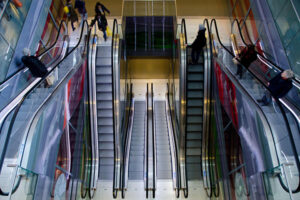Kintyre Investment GmbH is headquartered in Frankfurt/Main,and was established in 2010. The company is currently working numerous large-scale redevelopment projects, probably the most well know being the regeneration of the urban precinct on the former site of the “Märkisches Zentrum”. A former shopping centre that was built in Berlin in the 1960’s and it has been modernized and expanded several times over the past decades. It is centrally located in Reinickendorf’s “Märkisches Viertel” district, which was entirely planned on a drawing board. “Märkisches Zentrum” comprises a 37,000 sq m property as well as buildings with a total GLA of 55,000 sq m. It is currently used exclusively for retail and medical care. Now it is about be become the “Märkisches Quartier” due to its location and the surrounding cultural institutions, public pools, schools, churches.
Adam Pearce, a partner at Kintyre says, “In the course of this development the existing uses will be expanded with additional sectors including living, gastronomy, leisure & recreation, as well as urban logistics & gardening. It will also reinforce its position as an office location. Furthermore, a new and distinctive market hall, one of Europe’s largest, will complement this quarter with a strong focus on culinary delights. The design vocabulary will draw its inspiration from the time of the entire quarter’s formation to ensure that the center is seamlessly integrated into the new quarter.” Over 200 million euros will be invested to build this 90,000 sq m mixed-use residential and business quarter. Edeka, which will have a direct link to the market hall, has already been confirmed as the first anchor tenant.
In the context of rural depopulation
“Märkisches Quartier is a best-practice example for how urban regeneration works, and how to ‘future proof’ a complex property” says Pearce. Successful urban regeneration projects are able to combine a mix of uses, work/live/shop/play/and access to services in inner-city locations. It is more about the redevelopment of existing schemes than the construction of new buildings.
The main reason why the importance of urban regeneration cannot be underestimated is rural depopulation. According to the UN, 55% of the world’s population lives in urban areas today, a proportion that is expected to increase to 68% by 2050. Projections show that urbanization, the gradual shift in residence of the human population from rural to urban areas, combined with the overall growth of the world’s population could add another 2.5 billion people to urban areas by 2050. Whilst people followed jobs in the past, the opposite takes place today. Companies follow workforce, especially where workforce is creative and hard to find. This leads to new competition about the attractiveness of cities: amenities are not a „nice to have“ but a competitive advantage when competing for highly skilled workforce. Especially Millennials and the Generation Z wants to live in the heart of cities, and now due to Covid-19 the superfast broadband will be a key decider where to live.
Creating “identifiable places”
What does that mean for urban regeneration projects and companies that work on these projects? Adam Pearce of Kintyre says, “Historically, regeneration was driven by local and regional governments. Now shift has been more towards investment being made by private capital – such as private equity funds – as ‘mixed use’ schemes/projects are emerging as a standalone asset class moving alongside the traditional boundaries of office/retail/logistics etc.” Pearce continues by saying that previously the focus of developers was almost explicitly on the creation of living accommodation within re-generation projects. These days there is a far great focus on the full mixed-use concept. Occupation of the living units within schemes attract the younger demographic. However, there is also currently a strong movement to the inclusion of serviced “pre-aged care” accommodation for the more elderly within the community within urban development.
When it comes to the architecture of urban regeneration projects, John Morgan, the Director of leonard design architects in London emphasizes, “There is a strong focus on design and function, with increasing inclusion of shared public spaces. Many developers erect ‘buildings’. However, for a successful scheme they need to build an ‘identifiable place’ where people want to be and live–not ‘a building to live in’.” Morgan and his team collaborate with Kintyre on several projects. According to the architect, developers have historically pretended to care about the people who will live and work in their building and the surrounding community. Now they have to be “genuinely genuine.” Quality before quantity. “Previously it was about how much you got. Now it is about how good it is. It isn’t a supersize culture anymore”, says Morgan.
A number of challenges
One has to overcome quite a few hurdles to successfully launch an urban regeneration project. One of the biggest hurdles are the planning rights. Another hurdle comes from the investors: While a mixed-use property as a standalone investment class has become more recognized and accepted, there remains historic barriers to being more widely accepted as a primary investment class in its own right. One such examples are the investment fund classification of the ultimate future end investors/owners, who have historically had formal limits to the mixing of residential and commercial within investments.
Nicole Pötsch, Head of Acquisitions & Sales for Region North & Central Europe at Allianz Real Estate, says, “A mixed-use project, that would be an attractive investment for Allianz Real Estate, would have to consist predominantly of office space. However, it could be designed as a campus with further facilities, including co-working spaces, hotels, gyms, supermarkets, and restaurants/cafés. There is no clear definition of what mixed-use actually is and what kind of percentage must be residential, or if it needs to be residential at all. It is important, however, that the entire constellation meets the requirements of the tenants, investors, as well as the community surrounding the project.”
Another challenge is the growing involvement of private capital. And that capital needing a required return on investment, can result in a conflict between an optimized investment product, and an optimized scheme and living experience. Smart developers and investor however are reasoning that things like green and communal spaces, while not providing a direct return on investment via a rental income, are indeed essential for the success of the overall schemes they are delivering. One also has to consider that the modernization of existing buildings, with regard to upgrading to latest environmental and energy consumption standards is expensive. Pearce also mentions further, fundamental reasons, “Mixed use is difficult. Separate uses are easier to get funding for. But now we are seeing parts of buildings being acquired, for example Madison NY Fund’s purchase of ‘the ground two floors’ of the Bispevika development in Oslo. This is like buying a shopping center with apartments on the roof.”
Where will it all lead to?
It is clear that there is no way around urban regeneration projects on the global real estate market. After all, it is one of the highest growth sub sectors within property development – with investors increasingly valuing the diversity of income, and flexibility of space within urban precincts. The natural progression of incoming capital will continue, with Private Equity now well and truly operating withing the sector, and increasing number of institutional investors are committing to building their exposure to large mixed-use urban precincts. This will have the effect of compressing investment yields further. “Developers need to constantly question ‘their model’ and re-define it. Standing still is not an option. There is a wave of dynamic entrepreneurial developers who are getting big funds backing them to do things differently. They will be the future big players in the market”, says Morgan in closing.






